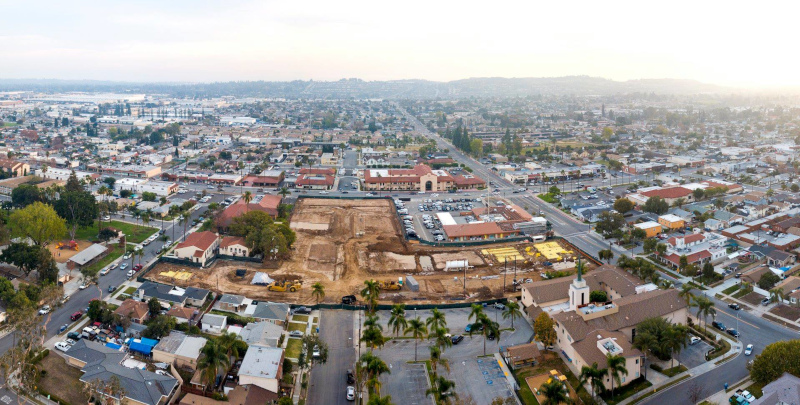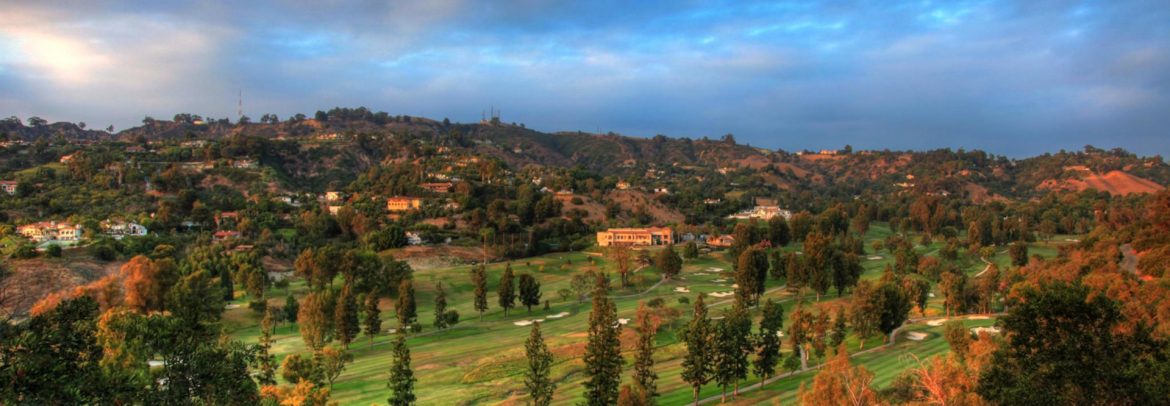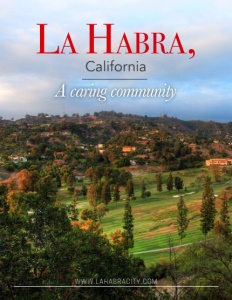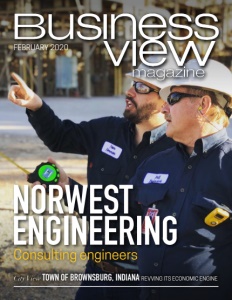La Habra, California
A caring community
Business View Magazine interviews Rob Ferrier, Asst. City Manager of La Habra, California, as part of our focus on best practices of American cities.
La Habra is a city in the northwestern corner of Orange County, California. The Spanish word, habra, means gorge or mountain pass, or, more poetically, “pass through the hills.” First discovered and used by Spanish explorers in the late 18th century, this habra was the natural pass between the Chino and Puente Hills into the San Gabriel Valley in what, today, is eastern Los Angeles County. In 1839, California’s Mexican Governor, Juan B. Alvarado, awarded a land grant of 6,700 acres, which included the present day cities of La Habra and La Habra Heights, to Mariano Reyes Roldan, who named his land Rancho Cañada de La Habra.
The City of La Habra was founded in 1896 and officially incorporated in 1925 with a population of 3,000. For many years, the area had been home to sheep ranchers, but by the early 20th century, after Rudolph Hass had perfected the Hass avocado in nearby La Habra Heights, it was the largest avocado center in southern California. Today, this 7.3-square-mile community, surrounded by a ring of state and federal highways, but still within an hour’s drive of Southern California’s beaches, mountains, and desert recreation areas, is home to approximately 70,000 people.
La Habra is known for its small-town feel, its numerous nonprofit organizations and service clubs, and its wide variety of shops and services, including family-owned businesses, mid-size brands growing in popularity, such as Trader Joe’s, Sprouts, and Northgate Markets, and corporate giants such as Costco, Sam’s Club, Kohl’s, Target, and Wal-Mart. La Habra has excellent schools, a well-rounded program of civic, recreational, social, and cultural services, a CIF Championship football team, a true community theater, a tennis center, and other sports facilities. The jewel of its park system is La Bonita Park, which is home to Girls Softball and the Disney Citrus Classic Softball Tournament.

The City administration and its staff of over 250 continue to focus on public safety, economic enhancement, redevelopment, beautification, and infrastructure improvements, as specified in its General Plan, which Assistant to the City Manager, Robert Ferrier, says was last updated in 2015. “The General Plan talks about how development will occur in the long term,” he explains. “It doesn’t specify what development will occur; it doesn’t specify when that development will occur; but it does specify the intensity of development and where the community wants to see development activity take place.”
And Ferrier places credit where credit is due, saying “The General Plan process could not have been as successful as it has been to date but for the vision and leadership of our City Council. They’ve been instrumental not only in leading the way, developing policies that will have a long-term, positive impact on our community, but also ensuring that we continue to work closely with our community, crafting well-thought local policies that are implemented efficiently, and with a mind to the service levels expected by our residents and the business community.”
In the two or three years before the General Plan update was completed, Ferrier says that the development community was paying close attention to the process, using it a basis to formulate their own plans for where and how residential, commercial, and office space development could occur. “And since we finished the whole process, we’ve started to see a lot of new residential development happen around town,” he notes. “I think we added about 500 units in the past three or four years, with a good mix of different types – there are some apartments, there’s some single-family, there are some townhome projects in there. And we’re seeing development along some of the corridors where we wanted to see it occur.”
“For example,” he continues, “Fairfield Residential, which is a big developer that does a lot of apartment projects around the country, approached us to do a project, once we had finished the General Plan, on a vacant parcel near the Imperial Highway. There was a run-down, burned-out, old hotel that had become defacto housing for transients and homeless folks. The developer acquired the property and built 300-plus market-rate apartment homes on the site, right across the street from one of our busiest shopping centers. So, that’s one big project that happened here in La Habra.
“Then, there are a couple of other projects occurring along La Habra Blvd., which is north of there and in the city’s downtown core: a couple of underused retail/commercial strip centers that were no longer viable were acquired by housing developers, one being the Olson Company, the other was Shea Homes. Both of them built townhome projects on them; one has 32 units, the other has 50 units, and both of them are close to being finished. So that’s another project happening in town.
“Probably the star project in La Habra, the one we’re most proud of, is a renovation of the Civic Center, which includes the City Hall, our police department, and our community center. We were approached by another housing developer, called City Ventures, who owned an option to acquire a vacant, run-down, commercial office building right across the street from our old city hall, to build 40-50 units on the site. The city owned a parking lot just south of that commercial office building and they wanted to see if they could incorporate that property into their larger project.
“As it happened, the city was in the process of looking at renovating a 60-plus-year-old city hall that had seen better days. Whenever it rained here, staff would have to put out buckets because the water would come right through into their offices. And so, we were trying to figure out how to do that when we were approached by City Ventures, and some of our brighter minds here put two and two together and thought, maybe there’s a way we can swap properties. We’ll take that old, vacant commercial office building and retrofit it into a new city hall, and then we can trade the old city hall property, at a profit to the City to help pay for the renovation, to City Ventures and then they can actually build a larger project – 70-plus units where city hall used to be.
“So, that’s a project that started in 2014-15, and we just finished about a year-and-a-half ago. It included the new city hall, the exterior renovation of our police department, and the expansion and renovation of our community center. Those three buildings sit on three of the four corners in the heart of downtown La Habra, at the La Habra Blvd./Euclid St. intersection. That project also included the renovation of a WPA-era veteran’s hall. Now that developer has sold some of the units and they’re near completion on the rest of them, so it’s done a lot to get development going in downtown La Habra and it’s that type of public/private partnership that everybody talks about. We actually did it here in La Habra.”
Going forward, the city would eventually like to create a multi-block downtown district along La Habra Blvd., bounded by Cypress St. to the east and Walnut St. to the west. “The General Plan envisions in that district, mixed-use development,” Ferrier adds. “The community and the city council asked us to look for incentives to provide the development community to re-energize the corridor and so, the incentive was to create development capacity along La Habra Blvd., which is currently built out with single-tenant, commercial retail. But if a developer or investor could assemble two to three properties, the General Plan allows for them to develop a more intensive, mixed-use development, where you would keep the retail on the ground floor, and be able to build residential on the second, third, and fourth floors. So, this is an attractive product type for the development community, because residential is hot, right now.”

A continuing focus on downtown development, however, is just one part of La Habra’s General Plan. “The community asked for a number of things,” says Director of Community & Economic Development, Andrew Ho. “One was to reinvest in city infrastructure and facilities. That’s where the Civic Center project came into play. We’re also embarking on a 20-acre park project, and we’re redeveloping an old landfill into a family-oriented park with recreation activities. We’ve accomplished a number of water projects, as well. So, infrastructure was one component, but as part of the General Plan, the community also asked for more economic development. So, our mission here in the Community & Economic Development Department is to build a vibrant community, and bring in new businesses.”
And, apparently, it has done just that. Ho mentions the addition of one major newcomer to La Habra: Trader Joe’s, the grocery store giant with over 500 locations in 42 states. “The facility used to be one supermarket and the developer went in and saw it as a value-add opportunity,” he recounts. “It means that they can take one store or one facility and sub-divide it into two, three, or four facilities and capture additional rent. So, this developer bought a 100,000-sq.-ft. Vons Supermarket, sub-divided it into three tenant spaces, and was able to bring to the community Trader Joe’s, Burlington, and CVS. They tripled their profits and the community, in turn, got three new businesses, two of which we did not have in town, one of them being a Trader Joe’s, which the community has been asking for, for the last 12 years. So, I think La Habra has the best land value in Orange County. For the amount of money invested, developers will have larger returns than in other Orange County communities.”
Ferrier believes that La Habra’s location makes it a particularly good place to establish retail businesses. “We’re surrounded by freeways,” he remarks. “There’s the 60 Freeway to the north, the 605 freeway to the west, the 57 freeway to the east, and the 5 and the 91 freeways to the south. All those freeways are about 15 minutes away from La Habra, placing us as a well situated suburban community benefiting from both the Orange County and greater Los Angeles County basins. This has become one of our greatest assets because the business community views La Habra as a key, centrally located market in the region. As such, we are home to big box retailers and warehouses like Costco, Sam’s Club, two Wal-Marts, a Target, and several other major distribution facilities in our industrial areas.”
While working to attract new business development, La Habra is also paying attention to its citizens’ desire for a more walkable and bikeable city. “Recently, we adopted a Master Street Plan and a Master Bikeway Plan,” Ho states. “Over the next couple of years, when we have the opportunities, we’ll invest in the creation of bike lanes and wider sidewalks. La Habra is mostly a built-out community, so a lot of the sidewalks and right-of-ways are in place, but we’re looking to enhance and widen existing sidewalks. We’re also looking to connect all of our bikeways and pedestrian linkages to our future bikeway trail. We’re in negotiations, now, with Union Pacific Railroad, to acquire a portion of their easement to do a bike trail. The segment that goes through La Habra will be one of the last major segments that need to be filled for the Orange County loop, a 60-plus-mile bike trail that goes across all of Orange County. It will also connect the OC Loop to trails in Los Angeles County. La Habra is one of the last steps in completing that entire loop, so we’re hoping to get that competed soon.”
Caring about what its citizens want and need is part of La Habra’s ethos, and what helps make this southern California city a wonderful place to live, work, and play. “The city’s motto is “A Caring Community,” says Ferrier. “That speaks to the sense of volunteerism that is alive and well in La Habra. It seems like every weekend, there’s some kind of an event going on; sometimes even during the week. And people come out to participate. We have an event every Christmas called Operation Santa where people donate either money or gifts to families in need during the holiday season. There’s another event called Love La Habra, which happens once or twice a year, where people can volunteer to help their community by participating in all kinds of community projects from helping landscape homes and schools, to painting buildings, to cleaning up properties of people who can’t do it themselves. Caring about your neighbor is something we take very seriously.”
AT A GLANCE
WHO: La Habra, California
WHAT: A city of 70,000
WHERE: Northwestern corner of Orange County, CA
WEBSITE: www.lahabracity.com
PREFERRED VENDORS
City Ventures – CityVentures.com
City Ventures Is California’s Leading Builder of Solar-Powered Homes
City Ventures is dedicated to partnering with cities to build homes in supply constrained markets that are attainable, close to jobs and way ahead of the industry in energy efficiency.
City Ventures entered into a multi-year partnership with the City of La Habra to accomplish the following goals – redesign and modernize the City’s Civic Center, revitalize La Habra Boulevard, and bring new for-sale housing to the Downtown La Habra.
Ultimately City Ventures helped the City acquire and finance the construction of a new City Hall building across the street from their old City Hall building which then made way for 71 new for-sale solar-powered homes on the old City Hall site.
Construction on the new City Hall was completed in early 2017 and construction of the new residential community commenced in summer 2017 and was completed by late 2019. However, the process started in 2013 when City Ventures was invited by the City to evaluate the Civic Center and make recommendations on how to enhance the underutilized area. That process led to numerous conceptual site plans and associated detailed financial analysis. After months of study and planning the City Council approved a Disposition and Development Agreement (DDA) in 2015 to greenlight the transformative multi-parcel project that allowed the city to move into a modern building and expand their operations from 21,000 to 47,000 square feet, bring 62 attached townhomes and 9 detached single family homes to the downtown, and enhance numerous other public facilities in the Civic Center such as the Police Department, Community Center, Lions Park, and Veteran’s Hall. This public/private partnership occurred after the dissolution of the Redevelopment Agency and took creativity, entrepreneurial thinking, and patience from all parties to bring the project to a successful fruition.




